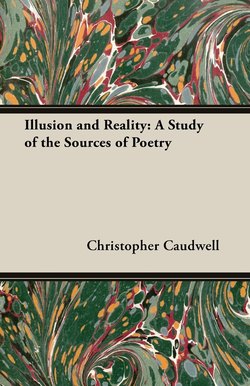Читать книгу Illusion and Reality: A Study of the Sources of Poetry - Christopher Caudwell - Страница 7
На сайте Литреса книга снята с продажи.
I THE BIRTH OF POETRY 1
ОглавлениеPOETRY is one of the earliest aesthetic activities of the human mind. When it cannot be found existing as a separate product in the early literary art of a people, it is because it is then coincident with literature as a whole; the common vehicle for history, religion, magic and even law. Where a civilised people’s early literature is preserved, it is found to be almost entirely poetical in form—that is to say, rhythmical or metrical. The Greek, Scandinavian, Anglo-Saxon, Romance, Indian, Chinese, Japanese and Egyptian peoples are instances of this generalisation.
This poetry is not “pure” poetry in any modern sense. We may describe it as a heightened form of ordinary speech, without committing ourselves to this as an adequate definition of poetry. This heightening is shown by a formal structure—metre, rhyme, alliteration, lines of equal syllabic length, regular stress or quantity, assonance—devices that distinguish it from ordinary speech and give it a mysterious, perhaps magical emphasis. There are repetitions, metaphors and antitheses which, because of their formality, we regard as essentially poetic.
This generalisation is commonly accepted, and there is no need to give more than a few instances. Hesiod thought it natural to use a poetical framework for a theological work and a farmers’ guide. Solon cast his political and legislative maxims into metre as a matter of course. The metaphysical speculations of the Aryan race in India were versified. Egyptian astronomy and cosmogony were poetical in form. Religion spoke always in rhythm or metre, and just as the epic grew out of a poetic theogony glorifying aristocratic history, so the early agricultural ritual, cast in metrical form, became the Athenian tragedy and comedy, and finally, after various vicissitudes, survives as poetical drama to-day in the opera and the Christmas pantomime.
Ethnological researches have further shown how any words worth preserving—weather saws, farmers’ wisdom, magical spells or the more refined subtleties of ritual and religion—tend among all races, in all ages, to a heightened language. This heightened language, as the people becomes self-consciously literary, is eventually set on one side as the specific vehicle of a department of literature known as Poetry, and distinguished to varying extents in different ages from the other uses of writing and speech. The form peculiar to poetry in a civilised age is the primitive form of all literature. A consideration of poetry must therefore be fundamental for a consideration of literary art.
Among primitives we usually meet with a heightening of language on formal occasions which disappears when the phrases are written down This heightening is effected by accompanying the words with music or rude rhythm—by chanting them It is tempting to assume, though by no means certain, that rhythmical or metrical language, before the invention of writing, was always accompanied by some rude music. Indeed one could make out a case for the supposition that music itself was generated at the same time as primitive poetry and that an aboriginal physical rhythm, expressed in gestures and leaps, in shouted words and meaningless ejaculations, and in artificial noises made by beating sticks and stones, was the common parent of dance, poetry and music Much evidence for this theory could be found in Africa. Significant, for instance, are the Ashanti talking drums described by Rattray, which transmit messages—not by code, an abstraction impossible to a primitive people lacking letters, but by mimicking the rhythm and pitch of speech on drums, so that the drums literally talk.
However, it would be dangerous to build our foundations on a hypothesis of this sort, which, however attractive, is too sweeping to be capable of rigorous proof. All that is assumed, therefore, is the general evolution of a written civilised literature from a special form of heightened language. At first monopolising nearly all traditional literature, this heightened language, as civilisation progresses, becomes confined to a niche of its own.
In its early stages this heightened language is usually in association with music and the dance. Even such a self-conscious literature as that of Periclean Athens does not seem to have seen any real distinction between poetry and music. Every form of Greek poetry had its appropriate musical, and in the case of dramatic poetry, its choreographic, accompaniment. This liaison persists in a shadowy form to-day. Music and poetry have long existed in their own right, but the frontiers overlap in the region of song and dance music.
This differentiation and specialisation of language with increasing civilisation is of course characteristic of all civilised functions The development of civilisation consists of a continually differentiating division of labour, which is not opposed to but is the cause of a continually integrating web of social economy. Just as the human body, because of the specialisation of its parts, is more highly integrated by an elaborate nervous system than a jelly-fish, from which parts can be severed which will continue to live, so the productive basis of society grows in elaborateness and differentiation at the same time as it becomes more and more unified. This is seen in any civilisation taken as a whole, which, as its economic basis elaborates and interpenetrates, becomes increasingly differentiated in all its cultural superstructure Poetry, maid-of-all-work in a simple tribal economy, becomes in the rich elaboration of a modern culture an activity which exists side by side with the novel, history and the drama. This development will give us the clue, not merely to the meaning of poetry, but also, if we follow the successive trails as they open up, to the significance in man’s life of all art and science. As man’s society develops, we must expect his art to show a corresponding development, and therefore to reveal with increasing clarity the implicit qualities of man, society and culture which made this development possible.
